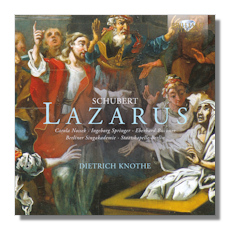
The Internet's Premier Classical Music Source
Related Links
- Schubert Reviews
- Latest Reviews
- More Reviews
-
By Composer
-
Collections
DVD & Blu-ray
Books
Concert Reviews
Articles/Interviews
Software
Audio
Search Amazon
Recommended Links
Site News
 CD Review
CD Review
Franz Schubert

Lazarus
- Eberhard Büchner, soprano (Lazarus)
- Carola Nossek, soprano (Jemima)
- Ursula Reinhardt-Kiss, soprano (Maria)
- Ingeborg Springer, mezzo-soprano (Martha)
- Horst Gebhardt, tenor (Nathanael)
- Bernd Riedel, baritone (Simon)
Berliner Singakademie
Staatskapelle Berlin/Dietrich Knothe
Brilliant Classics BRI94704
Apart from the overture and incidental music for Rosamunde (D797) as well as Fierrabras (D 796) and Alfonso und Estrella (D 732), Schubert isn't well known for his choral music and opera. This CD implicitly invites us to reconsider this area of the composer's work. Lazarus was begun (it's unfinished) around 1820, as far as we can tell. It was probably written for a specific occasion and/or performance: Easter 1820 perhaps. It's a work full of beautiful and affecting music. The playing and singing are very good. Though it might strike you as unlike other Schubert with which you are familiar. You'd probably not guess that the insistence and emotion of the end of "Voll Friede" [tr.4] are Schubert's.
Lazarus is more of a sacred stage work in the tradition of, and with their origins in, those by the likes of Carl Heinrich Graun, Johann Heinrich Rolle and C.P.E. Bach. The text is by the same theologian, August Hermann Niemeyer (1754-1828), as indeed supplied libretti for those composers. But it's also remarkable in its forward-thinking use of the balance between voice and instrument and – particularly innovative – in the distinction between operatic "numbers" (aria, recitative etc) and a more durchkomponiert (through-composed) approach. It can almost be claimed that, in a work like this, Schubert joined Weber to found the German Music Theatre tradition which saw its apotheosis in Wagner, and Richard Strauss. The syncopated progression in parts of "Wenn ich ihm" [tr.5], for instance, could almost be by Weber (or Mendelssohn). Indeed, there is a sense of liberation, of decidedly Romantic speculation and freedom which can only be heard otherwise in Schubert in the Unfinished Symphony and late piano sonatas.
The music for the burial scene in Act 2 (this is the raising from the dead episode in St. John's Gospel of the New Testament) wasn't completed; the music for the resurrection itself in Act 3 was never begun. Yet the work can still be followed with great pleasure – if a little regret that it wasn't, indeed, brought to fruition. If it had been, that would surely have further enhanced Schubert's reputation as a dramatic and innovative composer in yet another way.
This may be one of those cases where… If you think you know Schubert, think again! Time after time the gentle, sensitively-attuned orchestral musicians introduce music that is Beethovenian in its conception (as at the start of "Ich sterbe" [tr.13], for example), and which is taken up by thoughtful, perceptive singing with ranges of emotion and penetration of the essence of the subject matter. The overall sense of the work's architecture, of why what happens to Lazarus happens, is not lost either. Above all, the refrained singing styles (the subdued delivery of both solo and choral sentiments in "Heiliger, verlass ihn nicht" [tr.14], for instance) present character studies that are in perfect proportion for the scope of the work.
This re-issue by Brilliant at the end of 2013 is actually a recording 35 years older: from 1978 in the Christuskirche, Berlin (originally released on Berlin Classics 94452BC). The Berliner Singakademie and Staatskapelle are conducted by Dietrich Knothe (1929-2000) with a cast of half a dozen German singers who perform well; Eberhard Büchner and Ingeborg Springer stand out. Their singing is neither truly symphonic (robust and declamatory) nor fully sympathetic to more recent trends in historically informed performance practice – so showing a humility and reticence which good Lieder singers regard as essential. The projection of Schubert's musical message, though, is powerful and appropriate; it's perhaps closer to the kind of extrovert reverence to the Biblical import of Handel two or three generations earlier. Ultimately, as the work draws to a close, albeit probably not ending in the way that Schubert would have provided had he actually finished Lazarus, one is left fully satisfied. Color, character, pathos, clarity and some beautiful music have kept you company.
There are other recordings of Lazarus. The most recent is that by Gunschlbauer (Apex 4696177); and one with the music speculatively finished by Edison Denisov under Rilling (Hänssler Classic 98111). None is so distinguished as Knothe's here, though.
The acoustic reflects its age only minimally: the sound is more than adequate. There is a four page booklet with good background – particularly useful given the work's obscurity. Although the performers are only listed on the CD's back cover. Schubertians, particularly those fascinated by the position he occupies on the cusp of Classicism and Romanticism should not miss this release.
Copyright © 2014, Mark Sealey





















